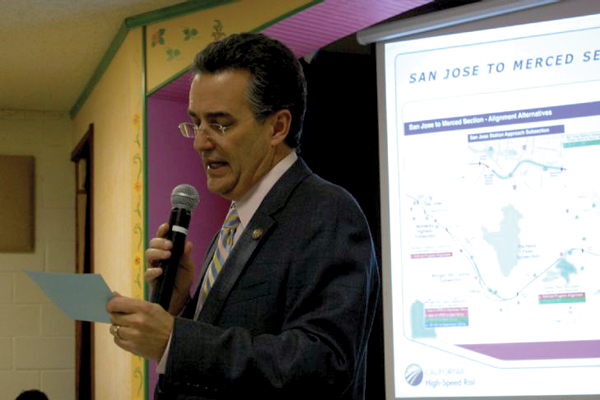
The California High-Speed Rail Authority’s east Gilroy station
option will be studied despite protests from residents and a Santa
Clara County agency dedicated to preserving agricultural land.
The California High-Speed Rail Authority’s east Gilroy station option will be studied despite protests from residents and a Santa Clara County agency dedicated to preserving agricultural land.
Questions on whether the City of Gilroy should include the east station proposal along with the downtown option in a “visioning process” study were raised when a letter from Californians Advocating Responsible Rail Design claimed the east station violated a 1996 agreement between the Santa Clara County Board of Supervisors, the City of Gilroy and the Local Agency Formation Commission, commonly known as LAFCO.
City Administrator Tom Haglund and City Councilman Perry Woodward, however, said the agreement was simply a strategy document, and didn’t bar Gilroy from studying the site for the $45-billion, 800-mile project.
The issue surfaced during a South County Joint Planning Advisory Committee meeting on March 11 in Morgan Hill, and was rekindled Tuesday night during a high-speed rail community meeting in San Martin.
Mike Wasserman, Santa Clara County District 1 supervisor, was presented with a letter from CARRD stating the east station option violated an agreement with LAFCO at the March 11 meeting. On March 17, LAFCO responded with a letter of its own on the study, which is funded by the Valley Transportation Authority.
Woodward said the debate over studying the east station had become “highly politicized.”
“It’s not rocket science,” Woodward said. “It’s just looking at a plan and commenting on it. We need someone to look at this and say, ‘These are the problems.’ ”
The ironic part of the debate, Woodward said, is while residents and LAFCO have protested the inclusion of the east station in the visioning process, that process likely would declare the downtown option a better alternative. Woodward said he supports building the station downtown if the tracks were trenched.
He said the 15-year-old LAFCO document should not be treated as a contract.
“It’s ‘how we’d like the world to be,’ ” he said. “It’s a statement of policy.”
Policy statements and strategy documents likely won’t be enough to persuade the rail authority one way or another, Woodward said.
“If they say they are going to run it through the east side of Gilroy, I don’t think anyone is going to stop them,” he said. “Until we see something saying that LAFCO trumps high-speed rail, the visioning process will go forward.”
Haglund wrote in an email that constructing transit-oriented development east of Highway 101 could require a change to the city’s general plan, but that was no reason to keep from studying the possibility that rail officials would select the east station as its final choice.
In a letter to Gary Kennerley, high-speed rail regional manager for the San Jose to Merced corridor, LAFCO Executive Officer Neelima Palacherla wrote the east station could strain city services, the extension of which would have to be approved by LAFCO if the station stood on unincorporated land.
Palacherla also wrote the station would be contrary to “all of LAFCO’s key objectives and is in direct conflict with state law which requires that LAFCO guide development away from existing prime agricultural lands.”
“We just wanted to bring this to the city’s attention and the community’s attention,” Palacherla said Thursday. “This will help them understand LAFCO’s policies and issues with the area in question.”
David Bischoff, Gilroy director of planning and environmental services, said LAFCO raised valid issues, but the organization’s claims wouldn’t hold much influence over the rail authority.
When asked if LAFCO could do anything to stop the east Gilroy station from being considered, Bischoff said no.
“The high-speed rail authority has the ability to place the station wherever they want,” he said.
The city would review the visioning process once it’s complete and send a recommendation to the rail authority. Still, the station location would be up in the air, he said.
“We don’t get the final decision,” Bischoff said.
Bischoff said Thursday the city had tabbed Berkeley based Design, Community & Environment to conduct the study, pending approval of the Gilroy City Council. The selection is scheduled to be brought before the Council during its April 4 meeting, City Clerk Shawna Freels said.
The visioning process will be funded by a $150,000 matching grant from the VTA.
Two more high-speed-rail community meetings will be held next week in Gilroy and Morgan Hill. The Gilroy meeting will be held at the Gilroy High School Student Center at 6 p.m. Tuesday. The second meeting will be held 6 p.m. Wednesday at the Morgan Hill Community & Cultural Center.
Both meetings will analyze sound and visual aspects of the project, Kennerley said.
var docstoc_docid=”74671754″;var docstoc_title=”LAFCO”;var docstoc_urltitle=”LAFCO”;LAFCO









